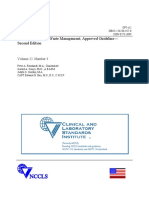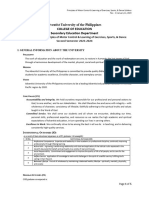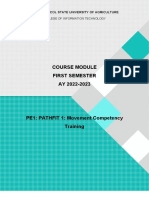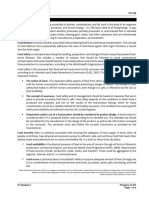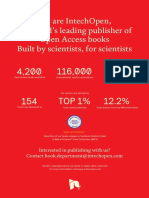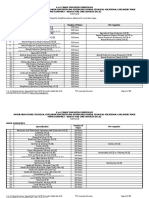0 ratings0% found this document useful (0 votes)
296 viewsDefine Human Movement
Define Human Movement
Uploaded by
Sheila LoverioHuman movement is the scientific study of how the human body works and focuses on improving the body for sport, fitness and wellbeing. It covers the physiological, biomechanical and psychological systems of the body. The skeletal system is composed of bones, ligaments, tendons and joints, with bone being a rigid connective tissue made of calcium. The muscular system permits body movement, maintains posture and circulates blood, and is controlled by the nervous system.
Copyright:
© All Rights Reserved
Available Formats
Download as DOCX, PDF, TXT or read online from Scribd
Define Human Movement
Define Human Movement
Uploaded by
Sheila Loverio0 ratings0% found this document useful (0 votes)
296 views1 pageHuman movement is the scientific study of how the human body works and focuses on improving the body for sport, fitness and wellbeing. It covers the physiological, biomechanical and psychological systems of the body. The skeletal system is composed of bones, ligaments, tendons and joints, with bone being a rigid connective tissue made of calcium. The muscular system permits body movement, maintains posture and circulates blood, and is controlled by the nervous system.
Original Description:
....
Copyright
© © All Rights Reserved
Available Formats
DOCX, PDF, TXT or read online from Scribd
Share this document
Did you find this document useful?
Is this content inappropriate?
Human movement is the scientific study of how the human body works and focuses on improving the body for sport, fitness and wellbeing. It covers the physiological, biomechanical and psychological systems of the body. The skeletal system is composed of bones, ligaments, tendons and joints, with bone being a rigid connective tissue made of calcium. The muscular system permits body movement, maintains posture and circulates blood, and is controlled by the nervous system.
Copyright:
© All Rights Reserved
Available Formats
Download as DOCX, PDF, TXT or read online from Scribd
Download as docx, pdf, or txt
0 ratings0% found this document useful (0 votes)
296 views1 pageDefine Human Movement
Define Human Movement
Uploaded by
Sheila LoverioHuman movement is the scientific study of how the human body works and focuses on improving the body for sport, fitness and wellbeing. It covers the physiological, biomechanical and psychological systems of the body. The skeletal system is composed of bones, ligaments, tendons and joints, with bone being a rigid connective tissue made of calcium. The muscular system permits body movement, maintains posture and circulates blood, and is controlled by the nervous system.
Copyright:
© All Rights Reserved
Available Formats
Download as DOCX, PDF, TXT or read online from Scribd
Download as docx, pdf, or txt
You are on page 1of 1
Define human movement.
The skeletal system is composed of four
In simple terms, human movement is the main fibrous and mineralized connective
scientific study of how the human body tissues : bones, ligaments, tendons, and
works, with a particular focus on improving joints. Bone: A rigid form of connective
the workings of the human body for sport, tissue that is part of the skeletal system of
fitness and wellbeing. It covers the vertebrates and is composed principally of
calcium.
physiological, biomechanical and
psychological systems of the body. The muscular system is an organ system
consisting of skeletal, smooth and cardiac
Human Movement Science muscles. It permits movement of the body,
maintains posture and circulates blood
Exercise Physiology. throughout the body. The muscular systems in
Movement Science. vertebrates are controlled through the nervous
system although some muscles can be
Occupational Science completely autonomous.
Friction is the contact force between two
objects moving against each other; the kind Inferior or caudal - away from the head; lower
of surface that objects have affects how (example, the foot is part of the inferior
objects move against each other. Gravity is extremity). Anterior or ventral - front
the force that pulls objects down slopes or (example, the kneecap is located on
makes them fall. A force can slow down or the anteriorside of the leg). Posterior or
speed up an object. dorsal - back (example, the shoulder blades
are located on the posterior side of the body).
The parts of the body that appear in this
video are: head,
face, eye,
eyebrow, cheek,
mouth, chin,
forehead, nose,
lip, ear, neck,
shoulder, elbow,
hip, forearm,
chest, arm,
hand, palm,
wrist, thumb,
finger, knee, leg,
foot, thigh, shin,
toe, calf, ankle,
heel.
You might also like
- Pe 101 Module 2 Physical FitnessDocument20 pagesPe 101 Module 2 Physical FitnessMISSY BETH VILLONES100% (1)
- Muscle and Bone Strengthening Exercises MALEDocument9 pagesMuscle and Bone Strengthening Exercises MALEMiranda C.100% (1)
- NCCLS - GP5-A2 - Clinical Lab Waste ManagementDocument7 pagesNCCLS - GP5-A2 - Clinical Lab Waste ManagementjimeneajNo ratings yet
- Pathfit Midterm 2Document6 pagesPathfit Midterm 2Xhejian EwanNo ratings yet
- Movement Competency Training Module No. 14Document3 pagesMovement Competency Training Module No. 14Jhon Keneth NamiasNo ratings yet
- PE 4 - Topics and ReferencesDocument3 pagesPE 4 - Topics and ReferencesRea Angela Dealca100% (1)
- PATHFITDocument4 pagesPATHFITJoy OronanNo ratings yet
- PE 1 Course SyllabusDocument14 pagesPE 1 Course SyllabusClifford Son TagsipNo ratings yet
- Obe 2014 - Physical Education 1Document8 pagesObe 2014 - Physical Education 1Jecxter BedañaNo ratings yet
- Unit 1: Introduction To Physical Education Lesson 1: History of Physical EducationDocument12 pagesUnit 1: Introduction To Physical Education Lesson 1: History of Physical EducationKaren Ann V. BACUSNo ratings yet
- PATHFIT 1 Module 1 2024 2025Document4 pagesPATHFIT 1 Module 1 2024 2025rustrovirgieNo ratings yet
- TRAD - DANCES - Final ExamDocument4 pagesTRAD - DANCES - Final ExamJvnRodz P GmlmNo ratings yet
- Module in Physical Education 2 Exercise Program BasedDocument21 pagesModule in Physical Education 2 Exercise Program BasedGeorge Vincent SismarNo ratings yet
- PATHFIT 1 MODULE CHAPTER 1 For CheckingDocument8 pagesPATHFIT 1 MODULE CHAPTER 1 For CheckingBing BertolanoNo ratings yet
- Individual Sports Grade 11Document10 pagesIndividual Sports Grade 11Edison RamilNo ratings yet
- Benson Handout Foundations of Mapeh PEDocument80 pagesBenson Handout Foundations of Mapeh PERHENCE TEJERO100% (1)
- PATHFit Module 1-5Document4 pagesPATHFit Module 1-5Mariefe Amada100% (1)
- PE 101 Course Pack 2023Document63 pagesPE 101 Course Pack 2023JM SolistNo ratings yet
- Pathfit 1 TQ Midterm ExaminationDocument4 pagesPathfit 1 TQ Midterm ExaminationKate Noreen Arsenal-CupinNo ratings yet
- Fitt 1 and Fitt 2Document25 pagesFitt 1 and Fitt 2Katrina Eunice AdridNo ratings yet
- Motivational Strategies in Sports and Exercise ParticipationDocument11 pagesMotivational Strategies in Sports and Exercise ParticipationGerald Corpuz100% (1)
- Socio-Anthropological Foundations of Physical Education and SportsDocument6 pagesSocio-Anthropological Foundations of Physical Education and SportsVershelle Emry RascoNo ratings yet
- Pathfit 1 PrelimDocument23 pagesPathfit 1 PrelimhiimleoNo ratings yet
- PRINCIPLES OF MOTOR CONTROL LEARNING EXERCISES SPORTS DANCE SYLLABUS 2nd Sem. 2024Document5 pagesPRINCIPLES OF MOTOR CONTROL LEARNING EXERCISES SPORTS DANCE SYLLABUS 2nd Sem. 20242059257No ratings yet
- Rhythmic ActivitiesDocument35 pagesRhythmic ActivitiesRobert Gallanes100% (1)
- PATHFIT3Document12 pagesPATHFIT3eric generaleNo ratings yet
- PE3 DanceDocument20 pagesPE3 Danceic icNo ratings yet
- Basic P.E Rhythmic ActvityDocument17 pagesBasic P.E Rhythmic ActvityJay R BayaniNo ratings yet
- Content Performance 2 Syllabus 2ND SemDocument2 pagesContent Performance 2 Syllabus 2ND Semarold bodoNo ratings yet
- Unit1 Fitness and Wellness For AllDocument7 pagesUnit1 Fitness and Wellness For AllJames Andrei LeonidaNo ratings yet
- Pe 101 Course Guide Sy 2022 2023Document8 pagesPe 101 Course Guide Sy 2022 2023bhfhewknsNo ratings yet
- Self Testing Activities - P.E Jasmir L. OmangDocument9 pagesSelf Testing Activities - P.E Jasmir L. OmangJodell OmangNo ratings yet
- Pathfit 1 Module MidtermDocument21 pagesPathfit 1 Module MidtermJOMICA SANTOSNo ratings yet
- Individual and Dual SportsDocument3 pagesIndividual and Dual SportsMelody Magsila SalvadorNo ratings yet
- Module 1 Pathfit 3 With RubricDocument2 pagesModule 1 Pathfit 3 With RubricDemi OrocNo ratings yet
- IN Physical Education 3 Rhythmic ActivitiesDocument70 pagesIN Physical Education 3 Rhythmic ActivitiesKian Mark LitadaNo ratings yet
- Pathfit 3Document57 pagesPathfit 3John Rafael AcuñaNo ratings yet
- Individual Sports: Swimming: Physical Education 2 Quarter Lesson 1 Grade 7Document20 pagesIndividual Sports: Swimming: Physical Education 2 Quarter Lesson 1 Grade 7Angelica GalindonNo ratings yet
- Physical Education: Leslie Anne M. FranciscoDocument37 pagesPhysical Education: Leslie Anne M. FranciscoKian GaboroNo ratings yet
- PATHFit 1 112Document19 pagesPATHFit 1 112Bobby Feliciano100% (1)
- 3PATH Fit 1 Activities WEEK1 8Document24 pages3PATH Fit 1 Activities WEEK1 8Xxx100% (1)
- Pathfit 2: Exercise-Based Fitness ActivitiesDocument5 pagesPathfit 2: Exercise-Based Fitness ActivitiesJoshua ManibogNo ratings yet
- Chapter 1: Nature and Scope of Physical Education, Exercise Science, and SportDocument39 pagesChapter 1: Nature and Scope of Physical Education, Exercise Science, and Sportmyratura100% (1)
- Philippine Traditional Games and SportsDocument3 pagesPhilippine Traditional Games and SportsMikee Balingit AndalNo ratings yet
- Physical Education 1 by Punzalan Et Al. 2019Document5 pagesPhysical Education 1 by Punzalan Et Al. 2019ANNA MARY GINTORO100% (1)
- Pe 101Document16 pagesPe 101MA. MICAH GIFT CALIBOSONo ratings yet
- PEDocument30 pagesPECarolyn Elizabeth BarcemoNo ratings yet
- New Module-Rhythmic-ActivitiesDocument112 pagesNew Module-Rhythmic-Activitiesromy imperialNo ratings yet
- Pe 2 Module 1Document9 pagesPe 2 Module 1chimNo ratings yet
- Appliedmotorlearning PPT No.1Document13 pagesAppliedmotorlearning PPT No.1Jojo JojoNo ratings yet
- Physical Education The Human MovementDocument26 pagesPhysical Education The Human Movementminagasaharahmae100% (1)
- Pathfit 3: Fitness and Physical Activity AssessmentDocument4 pagesPathfit 3: Fitness and Physical Activity AssessmentJhielo ArambulaNo ratings yet
- Q2-PPT-PE7-Wk2 (Table Tennis - Nature & Background)Document25 pagesQ2-PPT-PE7-Wk2 (Table Tennis - Nature & Background)Rima MeleloaNo ratings yet
- Path-Fit 3-Module-2-W-3-4Document11 pagesPath-Fit 3-Module-2-W-3-4Lynlyn EduaveNo ratings yet
- Pathfit 1Document9 pagesPathfit 1Minimi LovelyNo ratings yet
- Cha-Cha (P.E.2)Document10 pagesCha-Cha (P.E.2)Jed BentilloNo ratings yet
- Basic Resistance Training Movement PatternsDocument1 pageBasic Resistance Training Movement PatternsKELLY JOHN NOCANo ratings yet
- PATHFitDocument8 pagesPATHFitStephh Clacio100% (2)
- Recreational ActivitiesDocument1 pageRecreational ActivitiesAnalyn LafradezNo ratings yet
- CWTS Module 1 Edited PDFDocument8 pagesCWTS Module 1 Edited PDFAl GalagarNo ratings yet
- Group 2 - Activity #3 - Science of Human MovementDocument6 pagesGroup 2 - Activity #3 - Science of Human Movementsapphireriego01No ratings yet
- Charlene Resume 3021Document2 pagesCharlene Resume 3021api-242002271No ratings yet
- Short Case - Stoma ExaminationDocument6 pagesShort Case - Stoma Examination张虢袀No ratings yet
- An Evolutionary Theory of Dentistry (Science 2012 Gibbons)Document3 pagesAn Evolutionary Theory of Dentistry (Science 2012 Gibbons)RaviNo ratings yet
- 01 Handout 1Document4 pages01 Handout 1genesis nadonggaNo ratings yet
- Fabrication of MF ProsthesesDocument29 pagesFabrication of MF ProsthesesAmit GaurNo ratings yet
- Microsoft Word - Proctor TranscriptDocument107 pagesMicrosoft Word - Proctor TranscriptMays BagsNo ratings yet
- Project Report On HR Implications in Private Banking SectorDocument4 pagesProject Report On HR Implications in Private Banking Sectorlovely_latha0% (1)
- Template Diversity Questionnaire 1Document4 pagesTemplate Diversity Questionnaire 1neppoliyanNo ratings yet
- The Impact of Dementia On The ClinicalDocument8 pagesThe Impact of Dementia On The ClinicalihsansabridrNo ratings yet
- Spirituality Among Retired PersonsDocument4 pagesSpirituality Among Retired PersonsEditor IJTSRDNo ratings yet
- An Update On The New Investigations in Our ClinicDocument17 pagesAn Update On The New Investigations in Our ClinickhanasifalamNo ratings yet
- Feasibility Studies For Construction ProjectsDocument12 pagesFeasibility Studies For Construction ProjectsLokuliyanaN100% (2)
- Research 02 1edDocument76 pagesResearch 02 1edCDT 3C PIA CLEOJEAN100% (1)
- 15 - Takkar2017 PDFDocument6 pages15 - Takkar2017 PDFHarsya LuthfiNo ratings yet
- Contact Lenses and Associated AnteriorDocument13 pagesContact Lenses and Associated AnteriorJose Antonio Fuentes VegaNo ratings yet
- Paraphilias 1Document22 pagesParaphilias 1Rian Natoza GrandeNo ratings yet
- Smithsonian - September 2013 KDocument102 pagesSmithsonian - September 2013 Kjmguasch100% (2)
- Original Article: Surgical Infections Volume 19, Number 0, 2018 Mary Ann Liebert, Inc. DOI: 10.1089/sur.2018.134Document6 pagesOriginal Article: Surgical Infections Volume 19, Number 0, 2018 Mary Ann Liebert, Inc. DOI: 10.1089/sur.2018.134polomska.kmNo ratings yet
- Indiko and Indiko Plus BrochureDocument8 pagesIndiko and Indiko Plus BrochuresharenNo ratings yet
- GTU 104.2015 Teaching Timetable and Assessment ScheduleDocument9 pagesGTU 104.2015 Teaching Timetable and Assessment ScheduleJebatAl-KelantaniNo ratings yet
- Sleep ParalysisDocument19 pagesSleep ParalysisKatherine SajuNo ratings yet
- FINAL BOOK Choice Neighborhoods DCDocument129 pagesFINAL BOOK Choice Neighborhoods DCLydia DePillisNo ratings yet
- Introductory Chapter Physiotherapy and RehabilitatDocument6 pagesIntroductory Chapter Physiotherapy and RehabilitatShameem AliNo ratings yet
- Aspect TM 1806Document2 pagesAspect TM 1806Ari CleciusNo ratings yet
- Zelios: Saw and Reciprocating Saw Hand Power Tools - Including: Drills, CircularDocument3 pagesZelios: Saw and Reciprocating Saw Hand Power Tools - Including: Drills, CircularLuke CornettNo ratings yet
- Beauty Nail Care NC II CGDocument19 pagesBeauty Nail Care NC II CGRenato Nator100% (1)
- Hipopresivos, Eficaces o MarketingDocument3 pagesHipopresivos, Eficaces o MarketingJaviMéndezNo ratings yet
- Emission Testing and Standards in California: Updating Section 01350Document2 pagesEmission Testing and Standards in California: Updating Section 01350juli_radNo ratings yet
- Online Application Form Emergency Medical Officer, DHS (HDU Aspirational) Recruitment For NHM, UPDocument2 pagesOnline Application Form Emergency Medical Officer, DHS (HDU Aspirational) Recruitment For NHM, UPSonali SinghNo ratings yet


